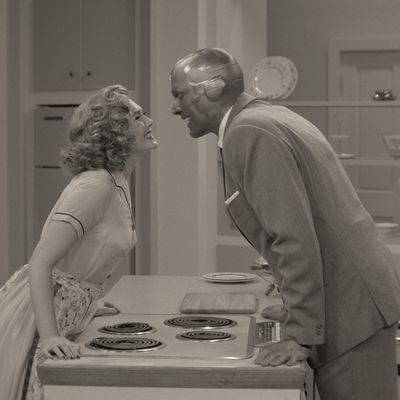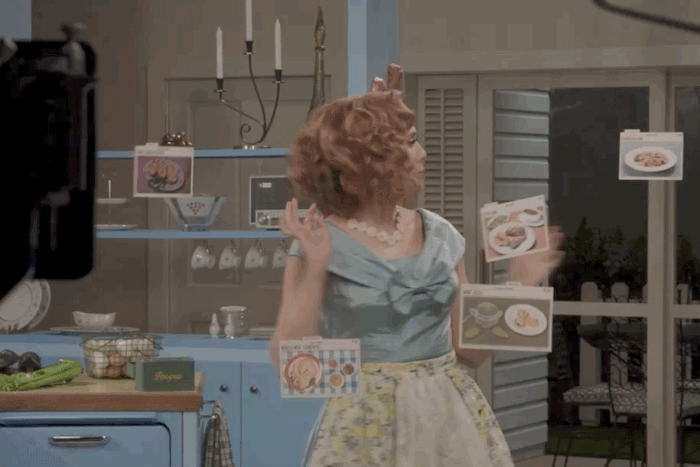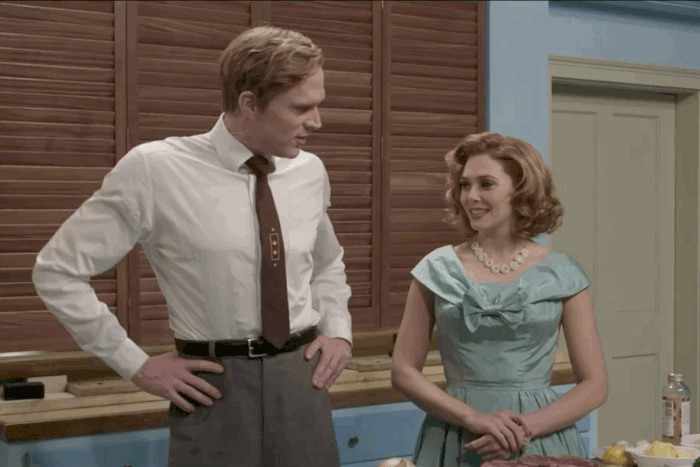
WandaVision was a gas, but now that it’s over (at least for now), Marvel is ready to reveal the secrets behind the sitcom world in its new series Assembled. Going behind the scenes on each of Marvel’s Disney+ series, the show’s first episode is focused on the creation of Wanda’s magic world and what went into getting everything just right in the sitcom’s period episodes. Special attention is paid to the 1950s-style premiere, with the filmmakers revealing some of their favorite behind-the-scenes moments and explaining just how far they went to make the episode feel authentic to the period, which included using era-accurate equipment, a live studio audience, and a fake butt. Here are the most appealing tidbits we learned about “Filmed Before a Live Studio Audience.”
There was a live studio audience
The episode title wasn’t just for kicks — showrunner Jac Schaeffer says that it was always their “dream” to have a live studio audience for the 1950s multi-camera episode. “We knew it was a risk, we knew it would be an expense — almost an indulgence,” she explains. “But for the actors, for the energy, and for the crew, it will be really exciting.” Entertainment Weekly reports that, to keep everything under wraps, audience members had to sign strict NDAs before coming to the taping. But some of the audience members (and the entire crew!) dressed in 1950s garb to set the scene, and all the chairs and railings that the audience used were modeled from the era, too.
Kevin Feige and Matt Shakman had lunch with Dick Van Dyke to get inspiration
Director Matt Shakman reveals that he and the Marvel Studios president sat down for a “lovely” lunch with real-life sitcom star Dick Van Dyke before shooting the show “so we could really get in touch with how they did it, and to be as authentic as we could, not just in how it would look and feel, but in how it was put together — the style, the way they rehearsed, the way they approached blocking and shooting.”
Camera lenses, lighting, and visual effects were all era-accurate
Executive producer Mary Livanos says in order to sell the sitcom premise, they wanted to make everything era-appropriate, meaning camera lenses, set decoration, and lighting all re-created from the 1950s. Wanda’s levitation was done on wires and rods, instead of the typical Marvel special effects we’re used to.
Debra Jo Rupp took the role for her great-nephew
Rupp, who played Mrs. Hart (predominantly in the series premiere and finale), said she took the job because her great-nephew said if she didn’t, “he would never visit [her] again. Well, here I am!” And while she enjoyed the 1950s episode — especially the costumes — she really liked filming some of the action shots in the finale.
Elizabeth Olsen was influenced by Full House tapings
Though she’d done live theater before, Olsen says shooting a television show in front of an audience “was like a strange, meta experience for me, because I grew up on the Full House set watching these live tapings on Fridays, never thinking that that would be a form of reality for me.”
Paul Bettany had a “fake butt”
To top it all off, both Olsen and Bettany wore Spanx underneath their costumes, but Vision’s required a little something extra: a fake butt (that Bettany slapped for emphasis). “It makes me stand properly, and it makes me kinda wanna do this, too,” he says before doing, well, this:
(If you subscribe to a service through our links, Vulture may earn an affiliate commission.)



